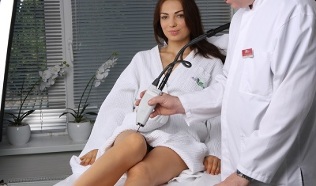If the leg veins are enlarged by varicose veins, how to remove the leg veins without surgery? Many people want to get rid of the unsightly dilated veins on the legs, which are not only ugly, but also harmful to health. But can you skip any surgery, or is there no other way?
How does this disease develop?

Can varicose veins be cured without surgery? In order to answer this question, it is necessary to consider what happens to the vein during the development of the disease.
Pathology is divided into several stages:
- The venous valve weakens and stops interfering with reverse blood flow;
- The valve insufficiency gradually increases, and the blood vessels begin to stretch to accommodate a large amount of reflux fluid;
- As the vein wall stretches, more and more blood stays in the deformed part of the blood vessel and congestion occurs, which worsens the blood flow rate;
- In the future, this process will spread to the vicinity of blood vessels and cause malnutrition of nearby tissues.
But is it always necessary to remove the vein? Is there a way to eliminate varicose veins without surgery?
When can conservative treatment be given?
In the early stages of the disease, no surgery was performed to remove the veins of the legs; to restore the full function of the venous valve, it was enough to restore the tone of the blood vessels.
But conservative treatment should be comprehensive, including:
- Change the patient’s lifestyle;
- Power correction;
- Compression effect;
- Drug intake.
Changes in lifestyle
Insufficient physical activity, or, conversely, excessive physical work, insufficient rest, and bad habits: all these lead to violations of blood circulation in the legs.
Lifestyle changes can help restore vascular tone. To do this, you need:
- Provide certain physical activity. Hiking, swimming, yoga, or fitness without intense exercise are all excellent ways to increase blood vessel tension and shrink venous lumen. If the gap is reduced, the valve will completely adhere to the container wall, preventing backfilling. In the early stages of development, physical exercise is one of the main ways to cure varicose veins without surgery.
- Arrange work and rest schedules. If you cannot avoid staying for a long time while working on your legs, you need to sit with your legs slightly upwards when you are resting. Do not stand up straight when working, but step on your legs, causing the calf muscles to contract. Regular muscle contractions increase blood vessel tension.
- Quit smoking and drink only a small amount of alcohol. If the patient continues to smoke and drink, he will soon have to undergo a vein enucleation.
Diet correction
People's diet plays an important role when varicose veins are not treated with surgery.
Exclude from the menu:
- Spices;
- Fat and fried foods;
- Carbonated drinks;
- Baked goods.
You need to limit the number of candies. It is best to use homemade jam, honey and dried fruits instead of sweets or cakes.

The menu needs to contain a lot of seafood:
- squid;
- Mussels;
- seaweed;
- Shrimp.
Seafood contains copper, which has a tonic effect on venous sounds.
In addition to the above products, it is recommended to eat more plant-based foods and drink natural juices and fruit drinks. You can eat liver and lean meat.
Compression action
This is bandaging and wearing elastic underwear (stockings, leggings). Elastic underwear is put on when lying down in the morning without getting out of bed, and taken off at night before going to bed. It is also suitable for bandages. Compression therapy helps prevent further stretching of the vein wall and reduces the negative effects of disease.
It is also recommended to wear compression underwear during the postoperative period, which will help shorten the recovery time and ensure the rapid restoration of the blood supply to the limbs.
However, compression therapy cannot be used as an independent method to avoid surgical removal of leg veins. It only helps prevent the negative consequences associated with venous blood flow development disorders.
Drugs
Prescribed drugs to increase venous tone.
Venotonics can be prescribed in the form of tablets, ointments or injections, but depending on the severity of the pathology, the dose can be selected individually.
In addition, symptomatic treatment is performed. For example, if there is a tendency for thrombosis, blood thinners can be prescribed and phlebitis-anti-inflammatory drugs can be used.
But all processing should be comprehensive. If a patient considers how to remove leg veins without surgery, but at the same time does not quit smoking and eat spicy food, then he will be disappointed-it is impossible. Without changing his lifestyle and eating habits, he will soon need leg vein surgery.
If you cannot do without surgical intervention

If conservative treatment is unsuccessful, and the patient often experiences pain and leg cramps, trophic ulcers or phlebitis, then surgery must be performed to reduce the consequences of the disease.
But minimally invasive treatments can also be used for vein surgery:
- Laser calibration:
- Hardening effect;
- Laser ablation;
- Radiofrequency ablation;
- Ligation;
- Small vein extraction.
Laser calibration
It is performed at the initial stage of the disease, only small blood vessels are deformed and spider veins appear on the skin. Percutaneous exposure to laser pulses causes the wall of the rosette to collapse and the lumen to close. But only through laser correction can the initial stage of the disease be cured. For this, a few sessions are sufficient. No need for rehabilitation after laser surgery.
Hardening effect
Laser ablation
Insert a sterile catheter into the expanded part of the vein and insert electrodes through it. The laser acts on the inner surface of the blood vessel, causing the vessel wall to collapse and completely close the lumen. The blood flow starts through the smaller blood vessels, and the veins exposed to the laser radiation gradually become thinner and disappear.
The postoperative time for this intervention can last as long as one day, but only a few months later can the cosmetic defects be completely eliminated.
Radiofrequency ablation
This method is similar to the laser method, but uses radio frequency radiation. Radiofrequency ablation is performed on large large blood vessels, and the irradiation time is approximately: from groin to knee or from knee to foot. The therapeutic effect can be achieved in 2-3 courses, but the complete disappearance of deformed veins will occur within a few weeks.
Ligation
Apply a ligature (dressing) on both sides of the large blood vessel area so that it can be closed from the blood flow system, which will begin to bypass the smaller veins. The overlapping parts of the binding thread fall off and grow firmly together. The ligation is performed in an outpatient setting under local anesthesia: a small incision is made in the skin, and then the vein is ligated. When there are already adverse consequences associated with impaired blood flow, ligation is considered a good way to eliminate varicose veins. "Closing" pathologically deformed veins from the circulation helps reduce pain and edema.
Small vein resection
The operation is also performed in an outpatient clinic under local anesthesia. The difference from ligation is that after ligation, the excised vein area is excised and removed through a small incision in the skin. Compared with surgical venectomy (the complete removal of veins), this small operation is considered to be less traumatic and requires little rehabilitation.
Although the minimally invasive treatment method is considered to be a surgical intervention due to the mechanical effect on the blood vessels, after the above-mentioned method is used to operate the leg veins, the negative impact of this intervention on the patient is minimal, and the post-operativeThe recovery time is short.
There is no need for surgery to eliminate varicose veins in the legs, but the success of the treatment depends not only on the method chosen, but also on the patient's readiness to receive medical advice.























